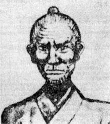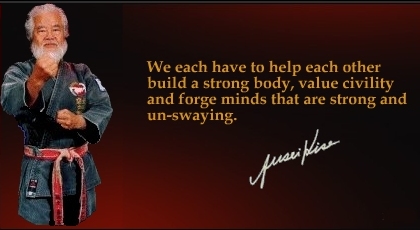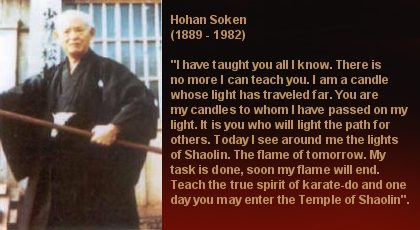Generations of secrecy have shed a veil of mystery around the history and origin of Okinawan karate. To a certain degree,
this veil of secrecy still exists. This, coupled with the general lack of written records, has created the lack of information
on the early years of Ryukyu martial arts. What little information we may have has come to us by scattered bits and pieces that
somehow have come into the possession of modern karate historians or from those of you who were fortunate enough to have been
told some of the history from an Okinawan sensei. Nevertheless, any attempt to write on karate “history” will leave many stones
unturned, and the following attempt is no exception. A lot of questions are left unanswered, perhaps one day we will know more.
Early History of Okinawa Karate
Early Okinawan karate, or tode (“China Hand”) as it was called, owes its origin to a mixture of indigenous Okinawan
fighting arts and various “foot fighting” systems and empty-hand systems of Southeast Asia and China. Being
seafaring people, the Okinawans were in almost constant contact with mainland Asia. It is quite likely that
Okinawan seamen visiting foreign ports were impressed with local fighting techniques and incorporated these
into their own fighting methods.
Interest in unarmed fighting arts increased during the 14th century when Chuzan King Sho Hashi established his rule over
Okinawa and banned all weapons. A more rapid development of tode followed in 1609 when the Satsuma clan of Kyushu,
Japan, occupied Okinawa and again banned the possession of weapons. Thus tode or Okinawa-te, as the Satsuma samurai
soon called it, became the only means of protection left to the Okinawans. It was this atmosphere that honed the
early karate-like arts of Okinawa into a weapon, enabling the island people to conduct a guerrilla-type war with the
Japanese samurai that lasted into the late 1800’s.
So tode or Okinawa-te was developed secretly, thus preventing the Japanese from killing the deadly art’s practitioners
and teachers. Tode remained underground until the early 1900’s, when it was brought into the Okinawan school system’s
physical education program.
Development of Karate-Do Styles and Systems
Chatan Yara was an early Okinawan master of whom some information exists. Some authorities place his birth at about 1670, in
the village of Chatan, Okinawa; others place his birth at a much later date. In any case, he contributed much to Okinawa
karate. He reportedly studied in China for 20 years. His bo and sai techniques greatly influenced Okinawan kobudo, his
Kata, “CHATAN YARA NO SAI,” “CHATAN YARA SHO NO TONFA,” and “CHATAN YARA NO KON” are widely practiced today.
Most modern karate styles can be traced to the famous Satunuku Sakugawa (1733-1857) called “Tode” Sakugawa. Sakugawa first
studied under Takabara Peichin of Shuri. Later, Sakugawa went to China to train under the famous Kusanku. Kusanku had been
a military attache in Okinawa. When Master Kusanku returned to China, Sakugawa followed and remained in China for six years.
In 1762, he returned to Okinawa and introduced his kempo (“fist way”). This resulted in the karate we know today. Sakugawa
became a famous samurai and was given the title of Satunuky or Satonushi, titles given to Okinawan warriors for service to
the Okinawan King. Sakugawa had many famous students; among them were:
1. MATSUMURA CHIKATOSINUMJO SOKON
2. MAKABE SATUNUKU
3. UKUDA SATUNUKU
4. MATSUMOTO CHIKUNTONOSHINUNJO
5. KOJO OF KUMEMURA
6. YAMAGUCHI OF THE EAST (BUSHI SAKUMOTO)
7. USUME OF ANDAYS
Sakugawa contributed greatly to Okinawan karate. We honor him today by continuing many of the concepts he introduced.
Sakugawa’s greatest contribution was in teaching the great “Bushi” Matsumura Sokon.
More History
Okinawa, the birth place of karate ,has produced many versions or individual styles of its bare-handed fighting art. Some
styles evolved from the teachings of different masters, other styles are indicative of a particular town, or villager family
tradition handed down from one generation to another. However in terms of the main stream of historical development of karate,
there are really only two styles. One style is known as Shuri-Te(Shuri hands) and the other is Naha-Te(Naha hands).
Naha-Te was developed around the principal port city of Naha, a large trade center. This method of Te (empty hand fighting)
was perpetuated by Bushi (warrior) Sakiyama (b.1819), Arakaki Kamadeunchu (1840-1920) and Kanryo Higashionna (1851-1915).
Naha-Te ultimately became known as Shorei Ryu (inspirational style) and evolved into the Goju Ryu and Uechi Ryu styles of
modern karate. The use of soft circlular blocks in Goju and Uechi Ryu make them similar although Uechi Ryu Shows a much
stronger Chinese influence.
Shuri-Te, on the other hand, was a style that developed mainly in the ancient city of Shuri, the ancient capital of Okinawa.
This is where the king and members of the nobility lived. Actually another style known as Tomari-Tewas a closely related
system and was considered to be an off shoot of Shuri-Te. Tomari-Te was practiced in TomariVillage. This village was located
close to Shuri and was populated mostly by farmers and fishermen. Tomari-Te eventually blended back into Shuri-Te. Ultimately
Shuri-Te developed into Shorin Ryu (Young Forest Style). Of the two styles of Okinawan Karate, it should be noted that the
Shuri-Te system is characterized by speedy movements rather than the more forceful movements of the Naha-Te system. Shuri-Te
was a more offensive style while Naha-Te was a more defensive one. The differences of style are really only surface differences
as both styles are derived from similar Chinese martial traditions. Naha-Te seems to have more of the soft-techniques and emphasis
on breathing and control of Ki (intrinsic energy) influenced by Taoist philosophy. While Shuri-Te appears to be derived from
the Shaolin Kenpo Style. The Shuri-Te style was practiced by the samurai of the court at Shuri Castle. The original Shuri-Te
and its evolved counterpart Shorin Ryu traces its history back over two hundred years in Okinawa.
Shinjo Choken is a “Dai Jo” or an important figure in Shorin Ryu’s history. He is one of the earliest known practitioners
of Shuri-Te. He was active in the late 1600’s and early 1700’s. It has been handed down that after Shinjo Choken another
martial artist by the name of Tode Sakugawa (1733-1815) became prominent in Okinawa. In fact, he is considered to be the
first true teacher of Okinawan Karate. Sakugawa’s martial art was a mixture of Shuri-Te and Chinese Kenpo. In 1756, Sakugawa
became a student of the Chinese military envoy Kusanku (also Kushanku). Kusanku was a highly skilled Kenpo master and famous
for his fighting ability. Kusanku did many things which influenced Shuri-Te’s and ultimately Shorin-Ryu’s development. He
taught many native Okinawans including Chatan Yara and Shionja of Shuri. He brought some of his students from China to Okinawa
and they spread the Chinese style on Okinawa. In addition, it is reported that Kusanku introduced a maneuver whereby the closed
fist was held in a chambered or ready position along the side of the torso (hikite)and then from this position a punch was
thrown, corkscrewing it in karate fashion, toward the intended target. Kusanku is also credited with the introduction of a
type of kumite or sparring to Okinawan karate. This kumite was referred to as Kumiai Jutsu or fighting technique.
After his training with Kusanku, Sakugawa became known as an expert in the Chinese style of fighting called Tode. This is the
basis for his nickname Tode (Chinese hand) Sakugawa. He is credited with being the first Okinawan Karate teacher. The
reasoning behind this is that Sakugawa is said to have combined the techniques of Chinese style Kenpo (Tode) with the
native Okinawan techniques of Shuri-Te and thereby formed the basis of a truly Okinawan Karate. He has three students who
distinguished themselves as excellent martial artists. They were Bushi Ukuda, Macabe Chokun and Bushi Matsumoto of Urazoe.
However his last and most famous student was Bushi Matsumura (1797-1889).
Bushi Matsumura

(1797-1889) Sokon Matsumura, also known as Bushi (Warrior) Matsumura and Shuri Matsumura (1797-1889), was one of the most
renowned martial artists of his time. He was known as a master “par excellence” and the organizer and founder of Shorin
Ryu Karate. Matsumura is responsible for carrying on the teachings of the old Shuri-Te martial arts. Matsumura chose the
name Shorin Ryu (Shaolin Ssuin Chinese) as the name of his Ryu because it is related back to the Shaolin Temple in China,
renowned for its fighters. Although some authorities believe that Anko Itosu (1830-1915), Matsumura’s student, is actually
responsible for adopting the name Shorin Ryu.
Matsumura was recruited into the service of the Sho family (Royal family of Okinawa) and eventually became the chief martial
arts instructor and bodyguard for the Okinawan King. At some point in his career, approximately 1830, he went to China
and studied the Shaolin style of Chinese Kenpo (fist method) and weaponry. It is also known that he traveled to Foochow
in Fukien province, China on numerous occasions as an envoy for the Okinawan King. After his return from China he organized
and refined the Shorin Ryu system of Okinawan Karate. Matsumura is credited with passing on the kata or formal exercises of
Shorin Ryu Karate known as Naihanchi I & II, Passai Dai (Matsumura no Passai), Seisan, Chinto, Gojushiho (fifty-four steps
of the Black Tiger), Kusanku (the embodiment of Kusanku’s teaching as passed on to TodeSakugawa) and Hakutsuru (white crane).
The Hakutsuru kata contains the elements of the white crane system taught within the Shaolin system of Chinese Kenpo. Another
set of kata, known as Chanan in Matsumura’s time, is said to have been devised by Matsumura himself and was the basis for
Pinan I and II. Matsumura’s Ryu has endured to the present day and the above mentioned kata are the core of Shorin Ryu Karate
today. Matsumura was given the title “Bushi” meaning warrior by the Okinawan King in recognition of his abilities and
accomplishments in the martial arts. In fact, Matsumura fought many times but was never defeated. His martial arts endeavors,
specifically the organization of Okinawan Shorin Ryu system has been the progenitor of many contemporary karate styles, Shotokan
Ryu and Shito Ryu, for example. Ultimately all modern styles of karate that evolved from the Shuri-Te lineage can be traced back
to the teachings of Bushi Matsumura. This includes Tae kwon Do (Korean Karate). Tae kwon Do was founded in 1955 by General Choi
Hung Hi, a member of the Korean Army. According to General Hi, “Tae kwon Do is a synthesis of Taekyon, an ancient Korean form of
unarmed combat which mainly employs kicking and karate, a Japanese martial art which chiefly relies on hand techniques”. General
Hi, the father of Tae kwon Do, studied Shotokan Karate in Kyoto while he was a college student in Japan.
Bushi Matsumura before his death passed on his menkyo kaiden (certificate of full proficiency) to his grandson, Nabe Matsumura.
Shorin-ryu is the Japanese pronunciation of the Chinese characters pronounced “Shaolin” in Mandarin-Chinese. Shorin/Shaolin
means “small forest”; “ryu” simply means “methods handed own,” “methods of learning” such as those of a school, or “tradition.”
Nabe Matsumura
![]()
NABE MATSUMURA brought the old Shorin-ryu secrets into the modern age. His name does not appear in many karate lineage
charts According to Hohan Soken (1889-1982), the purest teaching of Matsumura’s Shorin Ryu was carried on by Matsumura
Nabi(c.1860-1930). He received training in the family style of Matsumura Shorin Ryu which also included the secret techniques
of the white crane. The white crane system was reputed to be a secret family style that was only taught to immediate family
members. In his later years, Nabe Matsumura was referred to as Nabe Tanme or “old man” Nabe. He was known to be a stern and
disciplined teacher. He had only one student, Hohan Soken. It is said he was one of the top karate men of his time. He passed
on his menkyo kaiden to his nephew, SOKEN HOHAN
Hohan Soken
![]()
SOKEN HOHAN The next successor in the lineage of Matsumura Shorin Ryu was Hohan Soken(1889-1982). He began training at age
thirteen under his uncle, Nabe Matsumura. Soken had to work in the fields as a youth in spite of his Samurai heritage. This
was due to a political reorganization in the Ryukyu Islands and all of Japan as a result of the Meiji restoration. After
ten years of basic training under Nabe Matsumura, Soken began learning the techniques of the white crane or Hakutsuru. This
was in 1912 when he was twenty-three years old. According to Soken, this was a secret technique or training methodology which
was confined to the Matsumura family. Bushi Matsumura had learned the white crane system in China. Soken’s instruction in the
white crane technique emphasized balance training. One training method that he practiced was to perform the Hakutsuru kata on
a board floating in a pond. The board was just large enough to support his weight. The Hakutsuru kata, which was erroneously
referred to as the “White Swan” technique in a 1967 magazine article is the advanced level of Matsumura Shorin Ryu. The Hakutsuru
technique is the main part of the style. It manifests the Chinese concept of the soft (defensive) fist and balance training while
imitating the delicate movements of the white crane. In fact, this concept is inherent and woven throughout all the kata of
Matsumura Shorin Ryu. For example, Chinto uses the one legged stance of the crane extensively, Gojushiho uses the movements
of the neck and beak of the crane in its technique and Hakutsuru uses the wing (hane) of the crane. Master Soken also trained
for a while with Kenwa Mabuni (1889-1953) and Gokenki, a Chinese tea merchant living in Okinawa. Gokenki, Soken, Mabuni and
several other Okinawans all trained together as a group. Gokenki’s style was Hakutsuru Kenpo (white crane fist style) and he was
from the Fukien coast of China.
Up until the 1950’s Master Soken referred to his martial art as Matsumura Shuri-Te, then he began calling his style Matsumura
Seito(orthodox) Shorin Ryu. The empty hand kata of the style included those passed on by Bushi Matsumura (as previously noted).
However, Master Soken later added to his system’s repertoire Rohai 1, 2 & 3. Rohai means vision of a crane and was originally a
Tomari-Te kata dating back to the 1600’s. Hohan Soken was a highly respected master in Okinawa.
He helped pass on the legacy of Matsumura Shorin Ryu. Perhaps his life is reflected best in his own words – his death poem:
“I have taught you all I know. There is no more I can teach you. I am a candle whose light has traveled far. You are my candles
to whom I have passed on my light. It is you who will light the path for others. Today I see around me the lights of Shaolin.
The flame of tomorrow. My task is done, soon my flame will end. Teach the true spirit of karate-do and one day you may enter the
Temple of Shaolin”.
Hohan Soken’s light was most certainly passed on to a candle to help light the way for others. Hohan Soken gave his Menkyo
Kaiden to Fusei Kise prior to his death. The legacy of Matsumura Shorin Ryu continues with MASTER KISE FUSEI.
Fusei Kise
![]()
KISE FUSEI was born on May 4, 1935. He began his study of karate in 1947 under his uncle, Master Makabe. In 1955, Master Kise
became a student to Master Shingake Nobutake and received his shodan. In 1958, Master Kise began studying under Grandmaster
Soken Hohan, the third successor of Matsumura Seito Shorin-ryu karate-do. In 1960, he was a student of Grandmaster Nakamura
Shigeru, founder of the Okinawan Kenpo Karate-Do Federation, and qualified for his 7th degree black belt. After five years of
training, Master Kise became a shihan (“master”) on January 1, 1965, when he passed the 7th dan examination under Grandmaster
Nakamura. At that time, Master Kise taught and practiced Shorinji-ryu karate-do. During this time, he continued studying Shorin-ryu
under Grandmaster Soken. On January 1, 1957, Master Kise switched completely over to Matsumura Seito Shorin-ryu. On January 3, 1972,
Master Kise qualified for the hanshi title by passing the 8th dan examination held by Grandmaster Soken and Master Makabe. Sep 1st
1976 Master Kise qualified for his 9th Dan by Grand Master Hohan Soken. In 1977 Master Kise founded the Shorin Ryu Karate Kenshin
Kan Karate and Kobudo Federation. On Oct 25 1987 Master Kise was promoted to 10th Dan by Master Shigaru Tamaiya.
In 2001 the Government of Japan gave there Seal of Approval to the accuracy of Master Kise’s book. They have stated that he
(Grand Master Kise ) is the sole true heir to Matsumora Orthodox Karate, being passed down to him from Hohan Sensei. This has
been entered into the official Government Archives. This means there can be no more disputing the Lineage of Matsumora Orthodox
Karate. It belongs to our Grand Master.
In April of 2001 Grand Master Kise was selected by the Japanese Parliament to receive a prestigious Lifetime Achievement award.
He met with senators, other dignitaries and with the other Karate Grand Masters who are received awards (4 or 5 other Grand
Masters from Okinawa) at a luncheon in Naha.
More detail on Grand Master Kise “Click Here”



 Copyright © 2020 All rights reserved
Copyright © 2020 All rights reserved